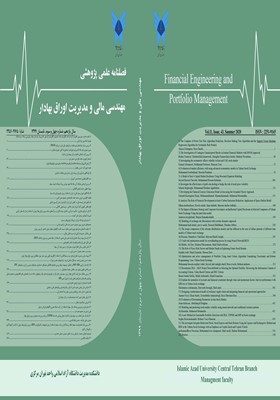ارایه مدل بهینه ریسک اعتباری فرایند تامین مالی جمعی با استفاده از شبکه عصبی پرسپترون چندلایه (MLP)
الموضوعات :علی ملکی 1 , علی زارع 2 , هاشم نیکومرام 3 , شادی شاهوردیانی 4
1 - گروه مدیریت مالی، واحد علوم تحقیقات، دانشگاه آزاد اسلامی، تهران، ایران
2 - گروه حقوق خصوصی، واحد علوم و تحقیقات، دانشگاه آزاد اسلامی ، تهران، ایران
3 - گروه مدیریت مالی، واحد علوم تحقیقات، دانشگاه آزاد اسلامی، تهران، ایران
4 - گروه مدیریت بازرگانی، واحد شهر قدس، دانشگاه آزاد اسلامی، تهران، ایران
الکلمات المفتاحية: ریسک اعتباری, شبکه عصبی پرسپترون چند لایه, تامین مالی جمعی,
ملخص المقالة :
هدف مطالعه حاضر، پیشبینی و ارایه مدل ریسک اعتباری جهت سرمایهپذیران تأمین مالی جمعی مبتنی بر بدهی است. با توجه به پیچیدگی ارزیابی ریسک، بهترین معماری شبکه عصبی الگوریتم پرسپترون چند لایه برای شبیهسازی انتخاب شد. جامعه آماری این پژوهش، اطلاعات مالی پرونده اعتباری/تسهیلاتی کلیه مشتریان (506 مورد) یکی از بانکهای کشور مربوط به سال 98-97 است. به منظور معناداری رابطه شاخصهای استخراج شده از نمونه با متغیر خروجی مدل (نکول و عدم نکول) اعضای نمونه توسط آزمون رگرسیون سنجیده شد. بدین ترتیب تعداد13شاخص بهعنوان بردار ورودی شبکه عصبی با سه لایه پنهان در دو گروه نکول و عدم نکول وارد مدل گردید. بر اساس نتایج شبیهسازی، مدل پیشنهادی توانست با خطای کمتر و دقت پیشبینی بالاتر (94.1) وزن هریک از شاخصهای ورودی به شبکه را محاسبه کند. همچنین ضریب تعیین برای دادههای آموزشی برابر (0.88)، آزمایش برابر (0.94) و ارزیابی برابر (0.84) بدست آمد که نشان دهنده توانایی برازش بالای مدل شبکه عصبی پیشنهادی است. یافتههای پژوهش نشان داد، از میان شاخصهای ورودی، درآمدخالص، با وزنی معادل 0.163، میانگین حساب جاری با وزنی معادل 0.123 به مراتب از اهمیت بیشتر و شاخص سابقه تحصیلات با وزنی معادل 0.053 از اهمیت کمتری در گروه عدم نکول شده برخوردار است.
http://www.lexology.com/library/detail.aspx
_||_
1) Talebi, Mohammad, Shirzadi, Nazanin, Credit Risk: Measurement and Management Tehran Side Publications 2019
10) Belleflamme, P., Omrani, N., Peitz, M., 2016. The Economics of Crowdfunding Platforms. CESIfo DICE Report, Volume 14.
11) Boot, A. W.A., 2017. The Future of Banking: From Scale & Scope Economies to Fintech, European economy. Banks, regulation, and the real sector
12) Buchak, G., G. Matvos, T. Piskorski, A. Seru, 2017. Fintech, regulatory arbitrage, and the rise of shadow banks, NBER Working Paper No. 23288
13) Davis, K. and J. Murphy, 2016. Peer-to peer lending: Structures, risks and regulation, JASSA The Finsia Journal of Applied Finance 3.
14) Durand, D. (1941). Risk element in consumer installment lending, national bureau of economic research.
15) Ebrahim Al-Gamal1, Dr. Abbokar Siddiq(2018) Significance of Credit Risk Management in Banking Industry in Yemen: A Study International Journal of Commerce and Management Research Volume 5; Issue 3; May 2019; Page No. 163-165
16) Fisher, R. (1936). Linear discriminant analysis. Annals of Eugenics, 7: 179-188.
17) Glantz, M. (2003). Managing Bank Risk: An Introduction to Broad-base Credit Engineering (Vol. 1). academic press.
18) Lopez, J.A., and Saidenberg, M.R. (2000). Evaluating credit risk models. Journal of Banking & Finance, 24: 151-165.
19) Madjid Tavana, Amir-Reza Abtahi, Debora Di Caprio, , Maryam Poortarigh (2018) An Artificial Neural Network and Bayesian Network model for liquidity risk assessment in banking Neuro computing 275 (2018) 2525-2554
2) Fast, Laurent. Neural Networks Basics: Structures, Algorithms and Applications, Nass Publications, Tehran, 2015
20) M. R. Khan and J. M. Baarmah (2017) 'Building a case for crowdfunding platforms in Saudi Arabia', Middle East Journal of Entrepreneurship, Leadership and Sustainable Development, Vol. 1, No. 1, pp.43]60.
21) Paolo Pietro Biancone (2017) Crowdfunding and Fintech: sharia compliant business model
22) Prasanna Prakash. "A Study on the Significance of Risk Management in Banking Sector", International Journal of Research in IT and Management (IJRIM). 2016; 6(9):135-139.
23) Yamaguchi (2014). Brazilian SEC not to limit equity crowdfunding. Lexology, April 25. Available at:
3) Minhaj, Mohammad Baqer. Fundamentals of Neural Networks and Computational Intelligence, Amirkabir University of Technology Publications, Tehran 2017
4) Agrawal, Ajay; Catalini, Christian; Goldfarb, Avi (2015). "Are Syndicates the Killer App of Equity Crowdfunding?". Rochester, NY: Social Science Research Network. doi:10.2139/ssrn.2569988. SSRN 2569988
5) Agrawal, Catalini & Goldfarb (2013). Some simple economics of crowdfunding. Josh Lerner & Scott Stern (eds.). Innovation Policy and the Economy. NBER Vol 14.
6) Altman, E. I. (1968). Financial ratios, discriminant analysis and the prediction of corporate bankruptcy. The journal of finance, 23: 589-609.
7) Aschenbeck-Florange & Nagel (2014). Crowdfunding is growing up - Welcome to the World of Regulation. Osborne Clarke. Available at: http://www.osborneclarke.com
8) Beaver, W. 1967. Financial Ratios as Predictors of Failure, Empirical Research in Accounting Selected Studies, 71-127.
9) Beck, Thorsten and Carletti, Elena and Goldstein, Itay, Financial Regulation in Europe: Foundations and Challenges (2016). CEPR Discussion Paper No. DP11147.
http://www.lexology.com/library/detail.aspx


